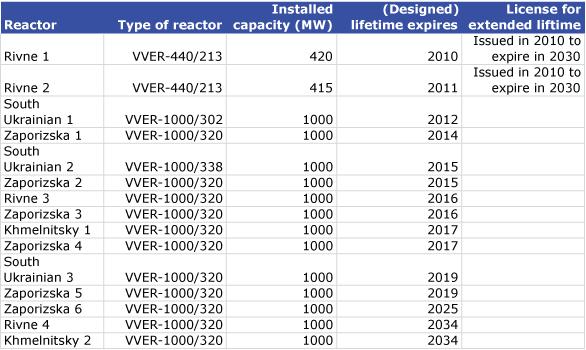Bankwatch report: EU supports nuclear life time expansion in Ukraine
Money from Euratom and the European Bank for Reconstruction and Development is to be used to finance the life time expansion of Ukrainian nuclear reactors, 12 of which had initially been scheduled to close down no later than 2020, according to an expert report published today by CEE Bankwatch Network.
8 March 2012

Money from Euratom and the European Bank for Reconstruction and Development is to be used to finance the life time expansion of Ukrainian nuclear reactors, 12 of which had initially been scheduled to close down no later than 2020, according to an expert report published today by CEE Bankwatch Network (1).
Ukraine’s national energy strategy for 2030 envisages that all of the country’s 15 nuclear reactors will have their life time expanded allowing the country to become an important source of electricity imports for the European Union. 12 of Ukraine’s 15 reactors were designed to finish operations before 2020; two of these 12 were supposed to be taken off the grid in 2010 and 2011 respectively but have already seen their licenses extended to operate for an additional 20 years each.
A plan for the safety modernisation of the 15 reactors to be implemented by 2017 is outlined in a „Safety Upgrade Project” (SUP) worth a total of over 1.45 billion euros and currently considered for financing by both the EBRD (up to 300 million euros) and Euratom („with the loan of a similar size”) (2). However, while the two European public institutions claim that they would be supporting the modernisation of the reactors, the expert study published by Bankwatch today shows that some of the measures included in the SUP for financing are necessary for the lifetime expansion of the plants and not for their regular functioning until the initially planned term.
„Our analysis has revealed that most of the modernisation measures included in the SUP, such as those related to component integrity and reactor protection systems, are conditions for the lifetime extension of the reactors,” comments nuclear expert Patricia Lorenz, one of the authors of the report. „Reactors that are scheduled for closure in 2012 or 2014 would normally not need the upgrades called for in the SUP unless there is a plan to use them past their original design life time.”
Iryna Holovko, Bankwatch national coordinator in Ukraine, adds: “What is particularly worrying is that this life time expansion is being done in total secrecy, without neighbouring countries and the European public in general being informed about these plans as would be required by international legislation such as the Aarhus Convention.
The EBRD and Euratom had initially requested assessing the SUP via a Strategic Environmental Assessment (SEA) but ended up accepting a much narrower Ecological Assessment that does not analyse either all the risks posed by this lifetime expansion or alternative scenarios. Even more, the SUP was prepared prior to the nuclear disaster at Fukushima, and before the EU called for rigorous stress tests to be conducted at all nuclear plants inside the union and in its neighbourhood.
“It is not acceptable that two European public institutions go ahead with considering this project before the Ukrainian stress test report is peer reviewed and accepted by the EU and before its results are made known to citizens whose lives could be directly affected by it,” adds Holovko.
According to Bankwatch, instead of supporting a very risky prolongation of Ukraine’s nuclear reactors beyond their design life time, the EU and the EBRD should help prepare these reactors for safe closure and decommissioning, while at the same time actively supporting alternatives to nuclear power: the development of local renewable energy sources and utilising Ukraine’s enormous potential for decreasing the energy intensity of the economy.
Notes for the editors:
1. Read the report online at:
https://bankwatch.org/sites/default/files/Ukraine-SUP-review.pdf
The report was commissioned by Bankwatch and authored by Austrian nuclear energy consultants Antonia Wenisch and Patricia Lorenz.
2. The European Commission plans to decide on the EURATOM loan in May 2012, the EBRD in September 2012. Read more about European public banks’ support for nuclear safety in Ukraine at:
https://bankwatch.org/our-work/projects/nuclear-power-plant-safety-upgrades-ukraine
and download report about EU support for nuclear expansion in Ukraine at:
https://bankwatch.org/publications/ignoring-chernobyls-lessons-how-eu-energy-security-expands-nuclear-energy-ukraine
List of design life time of Ukrainian reactors

For more information, contact:
Iryna Holovko
Bankwatch Ukrainian national coordinator
iryna at bankwatch.org
Tel.: +38 050 647 67 00
Patricia Lorenz
Nuclear energy consultant
patricia.lorenz at foeeurope.org
Mobile: 0043 676 44 64 254
Never miss an update
We expose the risks of international public finance and bring critical updates from the ground – straight to your inbox.
